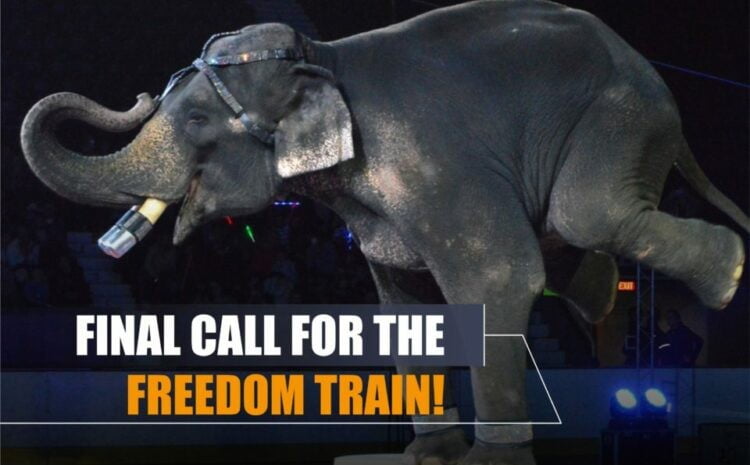
Final Call For Freedom Train
When we think of circuses, we think of huge tents, jokers, trapeze performances and a lot of fun. The concept of a circus came to India in the year 1880, when Vishnupant Chatre, after getting inspired by the Royal Italian Circus, came up with his own circus- The Great Indian Circus. Not just in India, but he also travelled across the United States.
Circuses have grown since, not just in India but across the world. And unfortunately, with them, grew the exploitation of animals. Tigers jumping through burning rings, lions walking in a line, elephants standing on stools, hippos playing with balls, dogs on bicycles and parrots balancing balls on their heads were considered ‘natural’ activities in a circus misleading children and adults alike. Because what happens to these animals behind closed doors is anyone’s worst nightmare. These animals, who are taken away from their families, beaten, abused and tortured to train in order to perform unnatural; tricks for human amusement, and are offer left to suffer without adequate food and veterinary care.
Fortunately, on the Animal Welfare board of India and FIAPO’s recommendation, the Central Zoo Authority (CZA) banned the use of any wild animals for performances in circuses in the year 2017. The ban came into effect after year-long inspections and monitoring by officials in which extreme cruelty to animals was reported. The ministry also deregistered several circuses in the country for training, exhibition and use of elephants for performances.
Very recently on the 28th of November 2018, the Ministry of Environment, Forests and Climate Change (MOEF&CC) issued a notice, proposing a ban on the use of all animals in circuses. This proposal is currently up for debate for a 30 day time period, after which the ban would be implemented in circuses across the country. An ecstatic moment for all animal lovers in the country, this notification will serve as the end of animal abuse in circuses once and for all. The Federation of Indian Animal Protection Organisations, along with several others, worked with the government for more than 4 years for this ban. Several eminent personalities and celebrities likeRaveena Tandon, Dia Mirza, Dr. Shashi Tharoor and Prashant Bhushan also shared their support to FIAPO’s End Circus Suffering campaign. Thousands of individuals showed their support by signing the petition and more than a thousand school children wrote postcards to the ministry asking them to ban the use of animals in circuses.
This notification could not come at a better time – just when India is hosting the largest circus in the world which does not use animals in their performances, Cirque Du Soleil. This circus is a model and should be taken as an example for others to evolve and include different cultural aspects of the country in their performances like sword fighting, mallakhamb, Gatka, Huyen langlon, Kalaripayattu, Mardani khel, Silambam and Sqay.With major players like Ringling Bros. and Barnum & Bailey Circus closing their doors in 2017, it is a clear proof that not only is using animals in circuses unethical, cruel and unjust, but the use of animals in circuses is also a recipe for economical failure. Use of different art forms and a clever use of trained individuals to entertain the audience are some ways in which the dwindling future of circuses in India can be brought back to life, also generating employment to thousands of talented individuals who are masters of several art forms across the country.